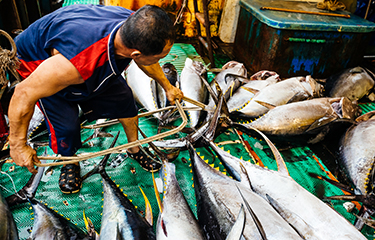The Indian Ocean Tuna Commission (IOTC) has, on the recommendation of its scentific committee, set the catch limit for yellowfin tuna at 287,140 metric tons (MT) in 2022.
IOTC Executive Secretary Christopher O’Brien said in early January that 24 of the commission’s members have been allocated varying catch limits in line with committee recommendations, with the European Union, Maldives, Seychelles, Sri Lanka, Pakistan, and Yemen taking the lion’s share of the yellowfin tuna catch allocations.
O’Brien said the published 2022 catch limit list for yellowfin tuna is provisional, because the 2021 catch data – used to calculate the 2022 catch limits – will not be available until June 2022 for all gears except longline, and until December 2022 for longline.
“For this reason, 2021 catch levels are assumed to be the same as those taken in 2020,” he said.
In 2022, the E.U. has been allocated a total of 73,146 MT of yellowfin tuna, down from 73,945 MT in 2021. The other top beneficiaries this year include Maldives, Sri Lanka, Seychelles, Yemen, and Pakistan, which were allocated 47,195 MT, 31,066 MT, 30,359 MT, 26,262 MT, and 14,468 MT, respectively. The lowest allocation went to France (territories), the Philippines, and the U.K. at 500 MT, 700 MT, and 500 MT, respectively.
There are no new catch limits for Madagascar, Oman, and Somalia. As for India, catch limits are calculated based on IOTC Resolution 18/01, which pertains to fishing vessels targeting tuna and tuna-like species in the Indian Ocean that are more than 24 meters long – or those under 24 meters if they fish outside their flag state within IOTC’s area of competence.
“India currently does not have such vessels matching the criteria and therefore, no catch limits apply for the country in 2022,” O’Brien said.
The IOTC is pursuing implementation of its resolution on 21/01 on an interim plan for rebuilding the Indian Ocean yellowfin tuna stock. The resolution came into effect on 17 December, 2021, and applies to all contracting and cooperating non-contracting parties except Indonesia, Iran, Madagascar, Oman, and Somalia – whose catch limits are based on IOTC Resolution 19/01.
The push to rebuild yellowfin tuna stocks in the Indian Ocean is driven by concerns related to the stock and the IOTC’s inability to rally its members into taking a common position on how to build the species’ stock levels.
“The Indian Ocean yellowfin tuna stock is overfished and subject to continued overfishing, with scientists warning that the stock could collapse within the next five years if fishing pressure is not reduced,” a previous statement by a consortium of environmental NGOs said.
The organizations blamed the IOTC's failure to significantly reduce catches on its failure to base its catch limits on the 2014 catch levels. Catches increased by more than 10 percent between 2014 and 2019, and higher catch limits are now rendering the rebuilding plan ineffective, according to the NGOs.
The IOTC adopted a resolution in June 2021 to rebuild the yellowfin tuna stock, but five contracting parties – Oman, Iran, India, Madagascar, and Indonesia – objected to the adoption of the resolution.
Photo by Anthony J Rayburn/MSC







